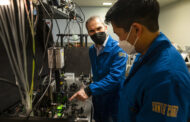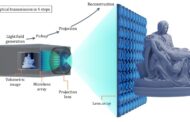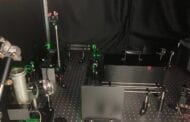
Credit: Unsplash/CC0 Public Domain
System-on-a-nanoparticle are designed to convert the brain’s electrical activity to optical signals detectable outside the body
Researchers have developed nanoscale sensors that could be injected into the body to noninvasively track brain activity using light. The approach could one day offer a new way to study the brain or assess patients’ brain functioning without the need for surgery or implanted devices.
Ali Yanik’s lab at UCSC’s Baskin School of Engineering will report on the technology, called NeuroSWARM3, at the virtual OSA Imaging and Applied Optics Congress held 19-23 July. Neil Hardy, a graduate student in Yanik’s lab, is scheduled to present their findings on Tuesday, 20 July at 20:00 PDT. The congress is co-located with the OSA Optical Sensors and Sensing Congress.
“NeuroSWARM3 can convert thoughts (brain signals) to remotely measurable signals for high precision brain-machine interfacing,” said Yanik. “It will enable people suffering from physical disabilities to effectively interact with external world and control wearable exoskeleton technology to overcome limitations of the body. It could also pick up early signatures of neural diseases.”
The approach offers a new way to monitor electrical activity in the brain using a system-on-nanoparticle probe that is comparable in size to a viral particle. Neurons use electrical signals to convey information to each other, making these signals crucial to thought, memory and movement. While there are many established methods for tracking the brain’s electrical activity, most require surgery or implanted devices to penetrate the skull and interface directly with neurons.
The researchers named their new technology Neurophotonic Solution-dispersible Wireless Activity Reporters for Massively Multiplexed Measurements, or NeuroSWARM3.
The approach involves introducing engineered electro-plasmonic nanoparticles into the brain that convert electrical signals into optical signals, allowing brain activity to be tracked with an optical detector from outside the body.
The nanoparticles consist of a silicon oxide core measuring 63 nanometers across with a thin layer of electrochromically loaded poly (3, 4-ethylenedioxythiophene) and a gold coating 5 nanometer thick. Because their coating allows them to cross the blood-brain barrier, they could be injected into the bloodstream or directly into the cerebrospinal fluid.
Once in the brain, the nanosensors are highly sensitive to local changes in the electric field. In laboratory tests, in vitro prototypes of the NeuroSWARM3 were able to generate a signal-to-noise ratio of over 1,000, a sensitivity level that is suitable for detecting the electrical signal generated when a single neuron fires.
“We pioneered use of electrochromic polymers (e.g., PEDOT:PSS), for optical (wireless) detection of electrophysiological signals,” Yanik added. “Electrochromic materials known to have optical properties that can be reversibly modulated by an external field are conventionally used for smart glass/mirror applications.”
NeuroSWARM can be thought of nanoscale electrochromically loaded plasmonic (electro-plasmonic) antenna operated in reverse: instead of applying a known voltage, its optical properties are modulated by the spiking electrogenic cells within its vicinity. Hence, NeuroSWARM3 provides a far-field bioelectric signal detection capability in a single nanoparticle device that packs, wireless powering, electrophysiological signal detection and data broadcasting capabilities at nanoscale dimensions.
The optical signals generated by NeuroSWARM3 particles can be detected from outside of the brain using near-infrared light with wavelengths between 1,000-1,700 nm. The nanoparticles can function indefinitely without requiring a power source or wires.
Other researchers have explored a similar approach using quantum dots designed to respond to electrical fields. Comparing the two technologies, the researchers found NeuroSWARM3 generates an optical signal that is four orders of magnitude larger. Quantum dots required ten times higher light intensity and one hundred times more probes to generate a comparable signal.
“We are just at the beginning stages of this novel technology, but I think we have a good foundation to build on,” said Yanik. “Our next goal is to start experiments in animals.”
In addition to Yanik, the co-authors of this study include UCSC graduate students Neil Hardy, Ahsan Habib, and undergraduate researcher Tanya Ivanov.
Original Article: Tiny, Injectable Sensors Could Monitor Brain Activity without Surgery or Implants
More from: The Optical Society | University of California Santa Cruz
The Latest Updates from Bing News & Google News
Go deeper with Bing News on:
Injectable sensors
- US Navy announces first MCM MP embarked on USS Canberra
The Navy installed sensors, unmanned vehicles, support containers and the software that enables Sailors to execute MCM operations from an Independence-variant LCS ...
- What’s Next In The Ozempic Era?
A new family of drugs is changing the way scientists are thinking about obesity — and more uses are on the horizon ...
- Brief Introduction to the Main Application Fields of Sensors
Sensors convert external signals into electrical signals and are used to monitor environmental parameters, detect the presence and position of objects, measure chemical composition and concentration, ...
- Standard Motor Products Introduces 268 New Numbers
Standard Motor Products, Inc. (SMP®) has announced the introduction of 268 new part numbers in its April new number announcement. This most recent release provides new coverage in 75 distinct product ...
- AI a ‘game-changer' for injection molding
As industries seek to optimize processes and enhance product quality, AI emerges as a game-changer in the world of plastic injection molding, RJG's Samantha Peterson writes in an excerpt from her book ...
Go deeper with Google Headlines on:
Injectable sensors
[google_news title=”” keyword=”injectable sensors” num_posts=”5″ blurb_length=”0″ show_thumb=”left”]
Go deeper with Bing News on:
Nanoscale sensors
- Diamond-based quantum sensing microscope offers effective approach for quantifying cellular forces
Cells rely on constant interplay and information exchange with their micro-environment to ensure their survival and perform biological functions. Hence, precise quantification of tiny cellular ...
- New iPhone 16 Camera Treatment May Put an End to Lens Flare
According to the latest iPhone 16 Pro supply chain rumor, Apple has been testing new anti-reflective optical coating technologies for its iPhone cameras to help eliminate lens flares and artifacts ...
- Nanoscale Thermodynamics: Exploring Energy Interactions at the Nanoscale
Nanoscale thermodynamics also finds applications in the development of highly sensitive and selective nanoscale sensors. Thermodynamic properties, such as the specific heat capacity or thermal ...
- Nanoscale movies shed light on one barrier to a clean energy future
Duke University. (2024, April 11). Nanoscale movies shed light on one barrier to a clean energy future. ScienceDaily. Retrieved April 22, 2024 from www.sciencedaily.com / releases / 2024 / 04 ...
- Meet the ‘quantum plumbers’ uncovering the mysteries of fluid mechanics at the nanoscale
According to standard fluid dynamics, the friction between a flowing liquid and the pipe wall shouldn’t change as the pipe gets narrower. However, experiments have shown that when water flows through ...
Go deeper with Google Headlines on:
Nanoscale sensors
[google_news title=”” keyword=”nanoscale sensors” num_posts=”5″ blurb_length=”0″ show_thumb=”left”]







